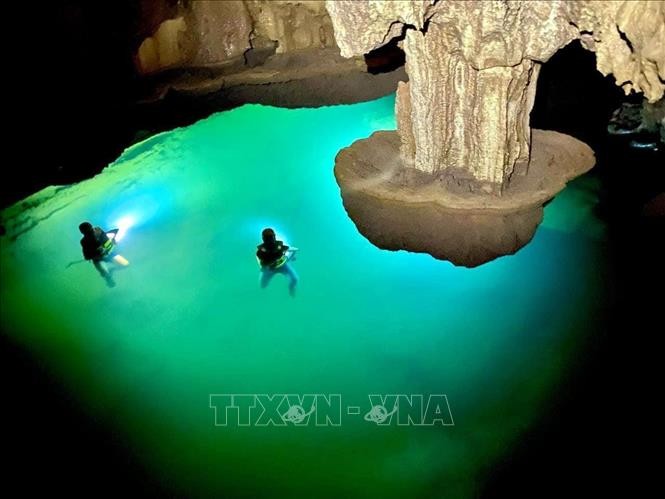(VOVWORLD) - A mysterious lake has been discovered in Thung Cave within the World’s Natural Heritage Phong Nha-Ke Bang National Park, in the central province of Quang Binh.
 A new lake has been discovered inside the pristine Thung Cave within the World’s Natural Heritage Phong Nha-Ke Bang National Park in Quang Binh province. (Photo courtesy of Quangbinh Tourism) A new lake has been discovered inside the pristine Thung Cave within the World’s Natural Heritage Phong Nha-Ke Bang National Park in Quang Binh province. (Photo courtesy of Quangbinh Tourism) |
It was discovered during an expedition by the Junglee Boss adventure tourism company and announced by Director of the company Le Luu Dung.
The lake is located around one kilometer from the entrance of the cave, in one of the most pristine caverns in the area, situated deep within a strictly protected zone of the national park.
It was found in an area about 15 meters higher than the main underground river branch inside the cave, making it look like it was 'floating' on the cave wall.
The lake is surrounded by stalactite columns with an underground river system underneath it. The newly-discovered lake has a transparent emerald green color and has been tentatively named Lo Lung (floating) lake due to its unique location.
The source of water flowing into the lake has not yet been determined, with the exploration team also discovering a passage along the cave wall of Thung Cave that traverses the main underground river branch.
According to Dung, the team members were unable to determine the lake's water source due to a lack of the necessary depth-sensing equipment, but plan on returning for further surveys and explorations in the area in the near future, he added.
The Phong Nha – Ke Bang National Park, which covers over 123,000ha, is home to many terrestrial and aquatic habitats, primary and secondary forests, sites of natural regeneration and tropical dense forests. It is also rich in large, often spectacular and scientifically significant caves, including Son Doong - the world's largest cave.
The area has twice been named as a world natural heritage site, first in July 2003, when UNESCO recognized the park for its exceptional global value in terms of geology and geomorphology.
Twelve years later, in July 2015, the park was once again honored, this time for its outstanding value in terms of evolutionary and development processes of terrestrial ecosystems which provide meaningful natural habitats for biodiversity conservation.